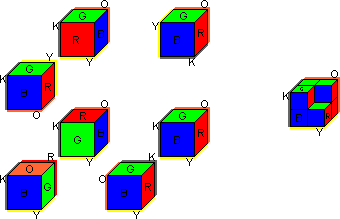


The Clark's Cube is a 2×2×2 sliding cube puzzle with a twist. Superficially
it is similar to the Varikon Box 2×2×2, and like
that puzzle it is a transparent box containing 7 cubes and a space. There are however
holes next to one edge of the box that give enough room for a cube to be rotated there.
Therefore, not only do the cubes have to be positioned correctly, they have to be oriented
correctly too.
The puzzle has white cubes with six coloured stickers on the faces (Black, Blue,
Green, Orange, Red, Yellow). Each cube has the six colours arranged differently so
they are all unique. When solved, each face of the box must show a single colour, including
the parts visible in the space.
The cubes are shown in the picture below.

The puzzle was invented by William H. Clark, and its patent, US 4,488,725, was published on 18 December 1984.
The picture below shows the solved arrangment of the cubes.

The easiest way to solve it is to first orient all the cubes properly. Note that one cube has all six colours matching the solved colour configuration (the cube at the bottom right back corner), four cubes have four colours correct, and two cubes (those at the bottom left in the picture) have only three colours correct.
Once you have the orientations correct, you can solve the puzzle using the solution for the Varikon Box 2×2×2.